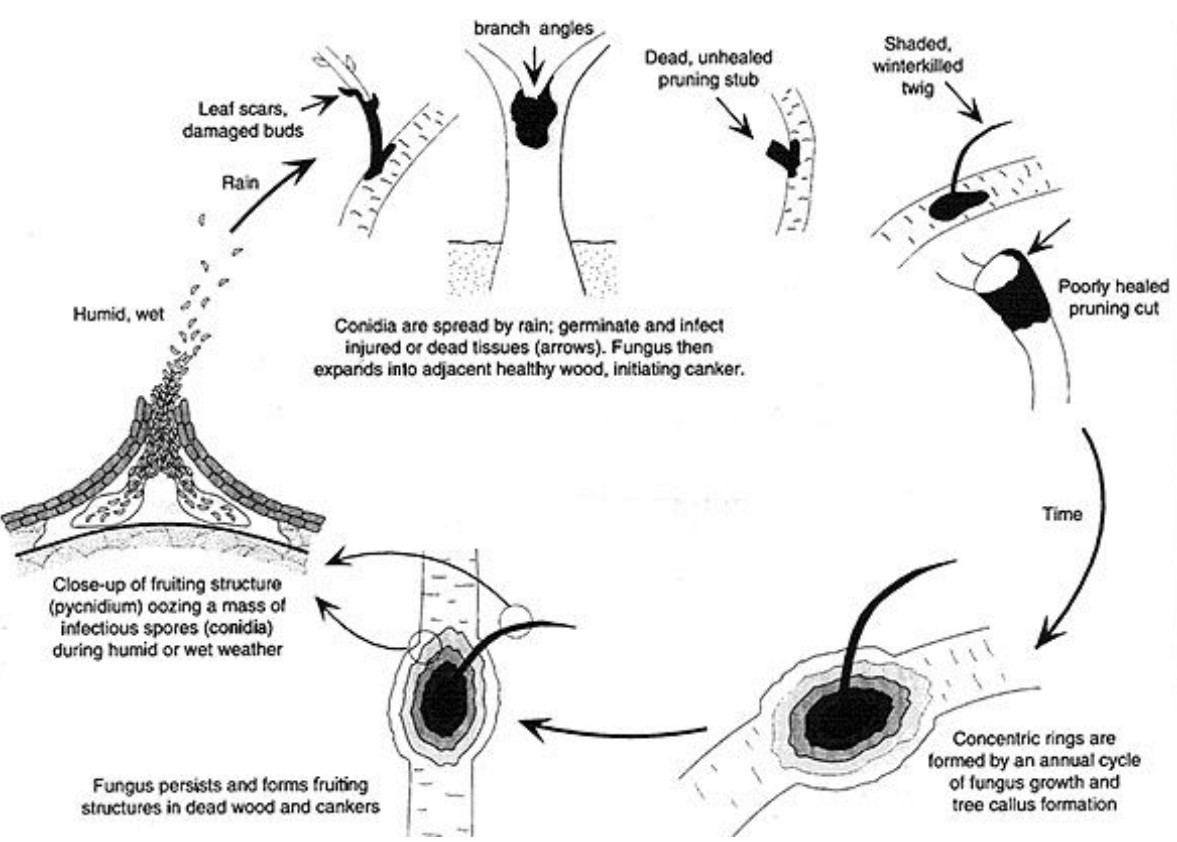What is Fungal Canker?
Fungus canker diseases are often the causal agents of twig and branch dieback in trees, deciduous and coniferous alike. They are especially common on trees which are marginally hardy in the current region, and are thus susceptible to winter injury, or on thin barked trees that are susceptible to sunscald injury. There are a number of fungi that can cause canker diseases. Some canker fungi attack only a few species of woody plants, while others attack many different kinds of hosts. A disease called Cytospora canker is one of the most commonly encountered canker diseases in Manitoba. Fruit trees, Mountain Ash, Spruce, Cotoneaster, and Poplar trees are often found to be affected by Cytospora fungus. Some other examples of fungal canker diseases are Hypoxylon, Phomopsis, Nectria, Neonectria, Botryosphaeria, and Diplodia. Almost any woody plant is subject to attack by canker fungi. Canker fungi often gain entry to a tree through bark that has been injured in some way such as by insects, pruning injury, winter injury or sunscald.
There is also evidence that some canker diseases can infect tissues that are apparently uninjured. Factors that weaken or stress woody plants leave them more vulnerable to attack by disease organisms, and natural openings for gas exchange, like leaf stomatas or bark lenticels, can be points of entry for these organisms.
Sign and Symptoms
The final stages of canker diseases usually manifest as branch dieback. Upon close inspection, areas of discolored, sunken, or shrivelled bark will likely be discovered. The diseased tissue may or may not have a definite visible edge or borderline. Sometimes, when the trunk or large branches are infected by canker fungi, wilting or yellowing of the leaves may occur before succumbing. Many of the fungi fully mature in dead twigs and branches, and will produce small fruiting bodies in the bark. They appear as tiny, pimple-like protrusions, and may be black, white, or other colours (like the reddish-orange spore bodies of Nectria). The production of these fruiting bodies and the infectious spore within often occurs during humid or wet weather. The disease is then spread by rain splash, wind, insects, or sometimes even pruning tools that are not properly cleaned.
Small branches and twigs are often killed within one season. On the trunk and larger branches, the canker may take several seasons to girdle and kill the stem.
Prevention
Watering & Fertilizing
- Your trees can be kept healthy by watering and fertilizing. Click here to learn more about watering.
Overwintering
- Guard against winter injury.
- Protect thin-barked trees against sun scald on the south and southwest side of the trunk and large branches through winter and spring (until the ground thaws).
- Boards and or burlap can be used to shade vulnerable areas or a coat of dilute white or light colored latex paint (dilute the paint: 1 part paint to 10 parts water) can be applied to the bark to reflect the sun’s rays.
Plant and Site Selection
- Guard against winter injury. Plant trees as hardy for the climate. Marginally hardy trees should be planted in a sheltered site.
Pruning
- When canker disease has been detected prune out all dead branches and any areas showing symptoms such as discolored, sunken or shriveled bark. Be sure that the cuts are made well into healthy areas.
- Pruning tools should be sterilized between cuts with rubbing alcohol, methyl hydrate or household bleach. Avoid pruning if the bark is wet, as moisture can cause fungal spores to germinate or bacteria to proliferate before the tree has chemically and structurally protected itself against microbial infections.
Control - What you need an arborist to do
Pesticide
- There is no effective chemical treatment available for fungus canker disease.


Tree Health Issues
Wondering about costs?

